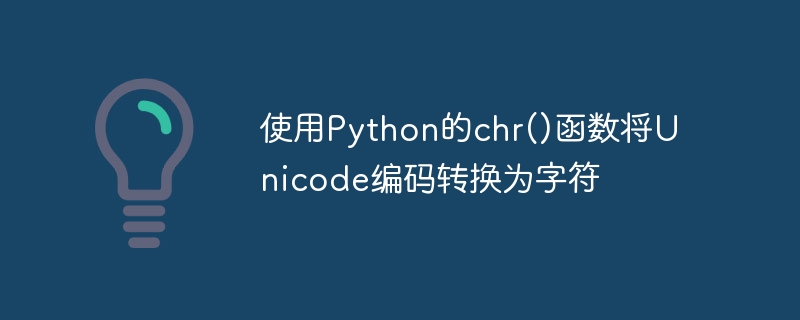Home >Backend Development >Python Tutorial >Convert Unicode encoding to characters using Python's chr() function
Convert Unicode encoding to characters using Python's chr() function
- PHPzOriginal
- 2023-08-22 09:29:092304browse

Convert Unicode encoding to characters using Python’s chr() function
In Python, Unicode is a standard character encoding system used to represent almost all of the world’s All characters. Unicode encoding uses 16 or 32 bits to represent a character, and when storing and processing characters within the computer, 8-bit binary is usually used. In Python, the Unicode encoding can be converted into the corresponding characters through the chr() function.
The syntax of the chr() function is as follows:
chr(i)
where i represents a Unicode encoding.
The following is a simple code example that demonstrates how to use the chr() function to convert Unicode encoding into characters:
# 定义一个Unicode编码 unicode_code = 65 # 使用chr()函数将Unicode编码转换为字符 character = chr(unicode_code) # 打印结果 print(character)
Run the above code, the output result is:
A
In this example, we define a Unicode encoding of 65 and pass it to the chr() function for conversion. The chr() function converts Unicode encoding 65 to the corresponding character 'A', and then stores the result in the variable character. Finally, we print the results through the print() function.
In addition to Unicode encoding of integer types, the chr() function can also accept other parameters that can be converted to integers, such as floating point numbers or strings. But it should be noted that only the integer part will be retained, and the decimal part will be ignored.
In addition, it should be noted that the chr() function can only be used to convert Unicode encoding to characters. If the passed parameter exceeds the Unicode encoding range (0 to 0x10FFFF), a ValueError exception will be thrown.
In summary, using Python's chr() function can easily convert Unicode encoding into corresponding characters. This is useful when working with file encodings, printing special characters, or performing character manipulation. Both beginners and experienced developers can easily use this function to achieve the desired functionality.
The above is the detailed content of Convert Unicode encoding to characters using Python's chr() function. For more information, please follow other related articles on the PHP Chinese website!

